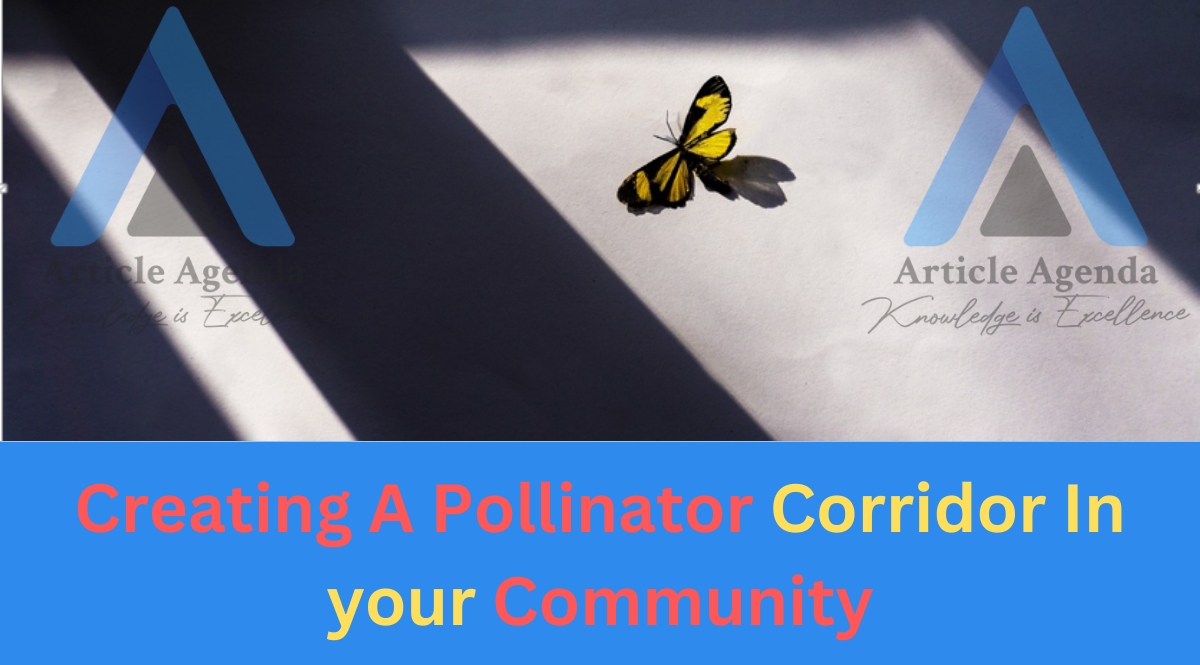Introduction
A Pollinator corridors play a crucial role in maintaining the health and biodiversity of ecosystems. These corridors provide a safe and connected pathway for pollinators, such as bees, butterflies, and birds, to move between fragmented habitats. By creating a pollinator corridor in your community, you can contribute to the conservation of these vital species and enhance the natural beauty of your surroundings. In this article, we will explore the importance of pollinator corridors, understand the role of pollinators in ecosystems, learn how to design and plan a corridor, select the right plants, engage the community, and monitor the success of your pollinator corridor.

Table of Contents
- Introduction
- Why are pollinator corridors important?
- Understanding the role of pollinators in ecosystems
- What is a pollinator corridor?
- Selecting the right location for a pollinator corridor
- Designing and planning a pollinator corridor
- Choosing the right plants for a pollinator corridor
- Maintenance and care of a pollinator corridor
- Engaging the community in creating a pollinator corridor
- Monitoring and evaluating the success of a pollinator corridor
- Conclusion and the future of pollinator corridors
Why are pollinator corridors important?
Pollinators, including bees, butterflies, and other insects, are essential for the reproduction of many plants. They facilitate the transfer of pollen between flowers, allowing plants to produce fruits and seeds. Without pollinators, many plant species would struggle to reproduce, leading to a decline in biodiversity. Additionally, pollinators also play a crucial role in supporting the food chain by providing food for other wildlife, such as birds and mammals.
Pollinator populations worldwide are facing numerous threats, including habitat loss and fragmentation, pesticide use, climate change, and diseases. As their habitats become increasingly fragmented, it becomes challenging for pollinators to find resources and suitable breeding grounds. This is where pollinator corridors come into play. These corridors act as green highways, connecting patches of suitable habitat and providing a safe passage for pollinators to travel and forage.
:max_bytes(150000):strip_icc():format(webp)/pollinator-garden-bees-getty-0323-2000-6e762a0955de49789e3dc3121007ed22.jpg)
Understanding the role of pollinators in ecosystems
To fully appreciate the importance of pollinators, it is essential to understand their role in ecosystems. Pollinators are responsible for the reproduction of approximately 85% of flowering plants worldwide, including many crops that humans rely on for food. They ensure the genetic diversity of plant populations by promoting cross-pollination, leading to healthier and more resilient plants.
In addition to their role in plant reproduction, pollinators also contribute to the overall functioning of ecosystems. They support the biodiversity of wildlife by providing a food source for many species, including birds, bats, and small mammals. Moreover, pollinators contribute to the pollination of wildflowers, which in turn support other insects and animals. Overall, pollinators are crucial for maintaining the balance and health of ecosystems.
What is a pollinator corridor?
A pollinator corridor, also known as a wildlife corridor or a greenway, is a linear stretch of land that connects fragmented habitats, allowing pollinators and other wildlife to move freely between different areas. These corridors provide safe passage and access to food sources, breeding grounds, and shelter, which are essential for the survival of pollinators.
When planning a pollinator corridor, it is important to consider the ecological needs of pollinators and the surrounding environment. The corridor should include a variety of flowering plants that provide nectar and pollen throughout the year, as different pollinators have different preferences and lifecycles. It should also incorporate diverse habitats, such as meadows, woodlands, and wetlands, to cater to the needs of various species.
Selecting the right location for a pollinator corridor
Choosing the right location for a pollinator corridor is crucial for its success. Ideally, the corridor should be located in an area with existing habitat patches or potential for habitat creation. Look for areas that have a mix of open spaces, gardens, parks, and natural areas. These locations can provide the necessary resources and support for pollinators.
Consider the proximity to other natural areas and the connectivity of the corridor to ensure it effectively connects existing habitats. Avoid areas with heavy pesticide use or high levels of pollution, as these can negatively impact the health of pollinators. Engaging with local conservation organizations, community groups, and landowners can help identify suitable locations and ensure collaborative efforts.
Read More : Will Virtual Reality HealthCare Services Take Off In
Designing and planning a pollinator corridor
Designing and planning a pollinator corridor involves considering various factors, such as the size and shape of the corridor, the types of plants to include, and the accessibility for pollinators. Here are some key steps to guide you through the process:
1. Assess the existing habitat: Survey the area to identify existing plants and potential pollinator habitats.Take note of the soil conditions, sunlight exposure, and water availability, as these factors will influence plant selection.
2. Determine the corridor size: Consider the available space and the needs of pollinators when determining the size of the corridor. A wider corridor allows for a greater diversity of plants and habitats, enhancing its functionality.
3. Select native plants: Native plants are best suited for supporting local pollinator populations, as they have evolved together over time. Choose a variety of flowering plants that bloom at different times of the year to provide a continuous source of nectar and pollen.
4. Create a planting plan: Map out the location of each plant species within the corridor, taking into account their growth habits and requirements. Group plants with similar needs together to optimize maintenance and care.
5. Consider habitat features: Incorporate features such as nesting sites, water sources, and sheltered areas within the corridor to provide additional resources for pollinators.
By following these steps, you can create a well-designed and functional pollinator corridor that meets the needs of both pollinators and the surrounding ecosystem.
Choosing the right plants for a pollinator corridor
Selecting the right plants for your pollinator corridor is crucial to ensure a diverse and abundant food source for pollinators throughout the year. Here are some considerations when choosing plants:
6. Native plants: Choose native plant species that are adapted to your specific region and climate. Native plants provide the most suitable resources for local pollinators and require less maintenance.
7. Flowering period: Select plants that bloom at different times of the year to provide a continuous food source for pollinators. This ensures that there is nectar and pollen available throughout the seasons.
8. Variety: Aim for a diverse range of plant species with different flower shapes, colors, and sizes. This attracts a wider range of pollinators with varying preferences.
9. Consider larval host plants: Some pollinators, such as butterflies, rely on specific plant species as host plants for their larvae. Include these host plants to support the complete life cycle of pollinators.
10. Avoid invasive species: Ensure that the plants you choose are not invasive species that can outcompete native plants and harm the ecosystem.
By selecting a variety of native plants that bloom throughout the year and cater to different pollinators, you can create a vibrant and thriving pollinator corridor.
Maintenance and care of a pollinator corridor
Once your pollinator corridor is established, it requires regular maintenance and care to ensure its long-term success. Here are some key maintenance tasks:
11. Weed management: Regularly remove weeds to prevent competition with native plants. Use manual weeding or targeted herbicides to minimize harm to pollinators.
12. Watering: Monitor soil moisture levels and provide supplemental watering during dry periods to support plant growth and flowering.
13. Pruning and trimming: Prune and trim plants as needed to maintain their shape, encourage healthy growth, and prevent overcrowding.
14. Pest control: Use integrated pest management techniques to control pests without harming pollinators. Avoid the use of broad-spectrum pesticides that can have unintended consequences.
15. Educate and engage: Raise awareness within the community about the importance of the pollinator corridor and encourage responsible use and respect for the space.
By staying actively involved in the maintenance and care of your pollinator corridor, you can ensure its ongoing health and viability for pollinators.
Engaging the community in creating a pollinator corridor
Engaging the community in the creation of a pollinator corridor is crucial for its success and long-term sustainability. Here are some ways to involve the community:
16. Education and awareness: Organize workshops, seminars, or webinars to educate the community about the importance of pollinators and the role of pollinator corridors. Share information about the benefits of creating a corridor and how individuals can contribute.
17. Collaboration with local organizations: Partner with local conservation organizations, schools, and community groups to pool resources, expertise, and manpower. Working together can help achieve a more significant impact and foster a sense of ownership within the community.
18. Volunteer opportunities: Provide opportunities for community members to actively participate in the creation and maintenance of the pollinator corridor. Organize volunteer planting days, weeding sessions, or monitoring activities to encourage community involvement.
19. Engage local businesses: Collaborate with local businesses, such as garden centers and nurseries, to promote the use of native plants and provide incentives for community members to plant pollinator-friendly gardens.
By involving the community in the creation and maintenance of a pollinator corridor, you can foster a sense of stewardship and create a lasting impact on the conservation of pollinators.
Monitoring and evaluating the success of a pollinator corridor
Monitoring and evaluating the success of your pollinator corridor is essential to understand its impact and make informed management decisions. Here are some ways to monitor and evaluate your corridor:
20. Pollinator surveys: Conduct regular surveys to document the presence and abundance of different pollinator species within the corridor. This can be done through visual observations, transects, or citizen science programs.
21. Plant assessments: Monitor the health and growth of the plants within the corridor. Keep track of flowering periods, plant diversity, and any signs of stress or disease.
22. Community feedback: Seek feedback from the community regarding their experiences and observations within the corridor. This can provide valuable insights and identify areas for improvement.
23. Data analysis: Analyze the collected data to assess the success of the corridor in supporting pollinators. Look for trends, patterns, and changes over time to guide future management decisions.
Regular monitoring and evaluation will help you adapt and refine your management strategies, ensuring the continued success of your pollinator corridor.
Conclusion and the future of pollinator corridors
Creating a pollinator corridor in your community is a meaningful way to contribute to the conservation of pollinators and enhance the ecological health of your surroundings. By understanding the importance of pollinators, designing a corridor that meets their needs, engaging the community, and monitoring its success, you can make a tangible difference.
Latest Post :
-
Smart Home Appliances in the UAE: Revolutionizing Modern Living
The UAE has long been recognized as a hub for innovation and technological advancement, and the adoption of smart home appliances is no exception. As the nation embraces the concept of smart homes, residents are experiencing a transformation in their daily lives, characterized by increased convenience, efficiency, and sustainability. This article explores how smart home…
-
(Artificial Intelligence) AI and ML (Machine Learning) : Transforming the Future
Artificial Intelligence (AI) and Machine Learning (ML) are two of the most transformative technologies of our time. They are reshaping industries, driving innovation, and opening up new possibilities in ways previously unimaginable. This article explores the fundamentals of AI and ML, their applications, and their profound impact on various sectors. Understanding Artificial Intelligence (AI) What…
-
Digital Marketing Services: Transforming Your Business in the Digital Age
In today’s digital-first world, businesses must leverage digital marketing services to remain competitive, attract customers, and drive growth. Digital marketing encompasses a broad range of tactics and strategies aimed at promoting products or services through digital channels. This article delves into the various types of digital marketing services available, their benefits, and how businesses can…




